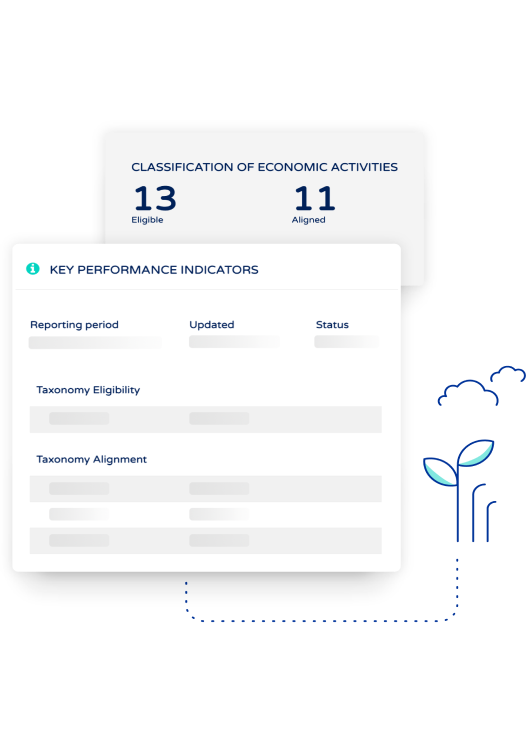
EU Taxonomy – All You Need To Know
EU Taxonomy came into force in 2020 and is an EU-wide reporting regulation aspart of the EU Green Deal plan to accelerate the green transition and direct investments towards sustainable business.
Several recent EU legislative development and plans tie into the EU Taxonomy in some way. In terms of a complete set of environmental, social and governance (ESG) factors, the EU taxonomy covers environmental and governance factors through technical screening criteria, and social and governance factors through company safeguards.
What is EU Taxonomy?
The EU Taxonomy is a classification system that defines activities that can be considered environmentally sustainable. This creates a common language that can be used by companies, investors, and governments to clearly and consistently express opinions or facts about sustainable activities.
📈 The EU Taxonomy defines a robust and science-based framework for companies and investors that provides environmental criteria for determining which economic activities substantially contribute to the EU Green Deal objectives. Companies need to determine if their economic activities comply with the technical screening criteria, if they comply with the minimum social safeguards, and they need to report on the key performance indicators (KPIs) related to the taxonomy-eligible and -aligned activities.
🌍 The purpose of the EU Taxonomy is to redirect investments into more sustainable projects and activities with the aim to align investments with EU’s climate and energy targets for 2030 and reach the objectives defined in the European Green Deal.
The EU Taxonomy also represents a strategic tool that helps companies plan the transition to a low-carbon, resilient and resource-efficient economy. As the EU Taxonomy is at the foundation of EU’s sustainable finance strategy, and therefore affects reporting requirements and green bonds and loans, for example through the EU Green Bond Standards (EU) 2023/2631.
Why do we need the taxonomy?
The EU Taxonomy targets sectors where a change towards sustainable activities is most crucial to enable an economy and a society that is more resilient against climate and environmental shocks such as global climate warming and the biodiversity crisis.
📊 The EU has defined ambitious and necessary climate and energy targets for 2030 and to achieve these targets, we need an urgent shift in how activities perform regarding greenhouse gas emissions and investment into activities that will allow us to reach the defined targets.
Whom is the EU Taxonomy intended for?
The EU Taxonomy targets financial market participants and non-financial companies in key sectors relevant to achieving the environmental targets defined under the EU Green Deal. The taxonomy also applies to any measures, taken by EU Member States or EU, that defines requirements for environmentally sustainable financial products or corporate bonds. For financial and non-financial companies, the EU Taxonomy defines classification and reporting requirements.

Non-financial companies’ requirements
From 2024 onwards, the scope that applies to non-financial companies regarding their requirement to assess their economic activities and report on their taxonomy-eligible and -aligned activities is defined by the corporate sustainability reporting directive (EU) 2022/2464 amendment to the Accounting Directive (2013/34/EU).
The gradual implementation of CSRD’s reporting requirement therefore also applies for EU Taxonomy reporting. Large, listed companies with more than 500 employees have already reported fully on taxonomy information since 2023. From 2025, with first reports published in 2026, large listed and non-listed companies with more than 250 employees need to report on their taxonomy-eligible and -aligned activities, and from 2026, listed SMEs will also start to report on their taxonomy information.
If a large company’s balance sheet and net turnover exceed the defined thresholds (25 000 000 EUR and 50 000 000 EUR, respectively as defined by the accounting directive 2013/34/EU), they will be required to report taxonomy information even if they have fewer than 250 employees. A similar threshold applies to listed SMEs. Eventually, also international companies with subsidiaries in an EU country will be required to provide taxonomy information for their European subsidiaries.
Sectors covered in EU Taxonomy
The main sectors currently covered by the EU Taxonomy are:
- the energy sector,
- segments of the manufacturing sector,
- construction of buildings and infrastructure,
- transport,
- forestry,
- environmental restoration,
- water supply and waste management,
- disaster risk management,
- information and communication,
- and services (eg. repair and sales of second-hand equipment/products.)
A few activities are defined for other sectors as well. Activities relevant to these sectors are defined within the environmental objectives of climate change mitigation and climate change adaptation.
EU Taxonomy timeline
The EU Taxonomy Regulation (EU 2020/852) first entered into force in the summer of 2020 and was extended with the technical screening criteria for the two first environmental objectives, climate change mitigation and climate change adaptation, and further requirements for reporting taxonomy information in December 2021. Reporting of alignment to the activities covered by the Climate delegated act has been required since January 2023.
Technical screening criteria for the remaining environmental objectives, the environmental delegated act (EU) 2023/2486, were published 21.11.2023 and applies from 1.1.2024. The environmental delegated act states that companies need to report eligibility to the new activities from January 2024 and alignment from January 2025.
Technical screening criteria of activities
The EU Taxonomy first developed technical screening criteria for activities under the environmental objectives of Climate Change Mitigation and Climate Change Adaptation to accommodate the urgent need to address greenhouse gas emissions and energy consumption.
The Climate Delegated Act, modified by the Complimentary Delegated Act, provides screening criteria for activities that contribute to, enable, or allow a transition towards sustainable actions under the climate change objectives. The climate delegated act is further amended through modifications and activity additions published with the Environmental delegated act.
With the publication of the Environmental delegated act, screening criteria are now provided for activities that contribute to, enable, or allow a transition under the objectives sustainable use and protection of water and marine resources, transition to circular economy, pollution prevention and control, and protection and restoration of biodiversity and ecosystems.
What is coming next?
Over time, technical screening criteria for further activities will be gradually added to the EU taxonomy. This is seen from the addition of certain activities related to nuclear energy production and energy production from natural gas through the Complimentary Delegated Act, and the addition of activities published in November 2023.
The criteria themselves will also be revised regularly, for transitional activities at least every three years, and may be updated to keep up with technological development, the availability of new scientific evidence that justifies updating or adding criteria, and to keep the criteria aligned with policy objectives. The Platform on Sustainable Finance will be assisting the Commission in the process of improving the usability of the taxonomy, expanding the taxonomy, and provide recommendations on the development of criteria.
What (else) do you need to know about the EU Taxonomy?
Up until now, we have talked about what the Taxonomy is, how the taxonomy will develop over time, and who are affected by the taxonomy, but we have not yet talked much about what requirements are defined under the taxonomy and what the affected companies actually need to do to comply with these.
💡 The taxonomy requires companies to identify which of their business activities are covered by the EU taxonomy (eligibility), meaning the activity is described in any of the delegated acts defining technical screening criteria, and which comply with the technical screening criteria defined for these activities (alignment). The taxonomy further requires companies to report on their performance by disclosing defined financial key performance indicators (KPIs).
Taxonomy-aligned activity is:
The taxonomy defines three conditions that a company’s economic activity must meet to be recognised as Taxonomy-aligned. It needs to:
• make a substantial contribution to at least one environmental objective,
• do no significant harm to any other environmental objective, and
• the company need to comply with the defined minimum social safeguards.
Taxonomy – 6 environmental objectives
There are 6 environmental objectives defined in the taxonomy that are referred to here:
- climate change mitigation
- climate change adaptation
- sustainable use and protection of water and marine resources
- transition to circular economy
- pollution prevention and control
- protection and restoration of biodiversity and ecosystems.
In practice, this means that the companies need to comply with all the technical screening criteria defined for their activity to cover the requirements of making a substantial contribution and avoiding doing harm to other environmental objectives.

Taxonomy – safeguards
The third requirement concerns compliance with the minimum social safeguards on a company level. The safeguards are defined as:
• the OECD Guidelines for Multinational Enterprises,
• the UN Guiding Principles on Business and Human Rights,
• the ILO declaration on the Fundamental Principles and Rights at Work,
• the eight fundamental conventions of the ILO on human and labour rights,
• the International Bill of Human Rights.
To comply with the minimum safeguards, companies are required to develop and implement sufficient social due diligence processes that cover the topics human rights, including worker and consumer rights, bribery and corruption, taxation and fair competition following the above-mentioned international standards.
The Platform on Sustainable Finance on the safeguards (Final report on minimum safeguards) provide further recommendations on what it means to comply, or not comply, with the minimum social safeguards.
EU Taxonomy – Key performance indicators
In addition to ensure that the company and the company’s economic activities fulfil the above requirements, companies also need to report on performance related to those requirements. For this purpose, the Disclosures delegated act defined key performance indicators (KPIs) for the different actors needing to report taxonomy information.
The KPIs defined for non-financial companies relates to turnover, capital expenditure (capex) and operational expenditure (opex). The companies need to disclose the proportion of the turnover (and capex and opex) that is aligned with the taxonomy, the proportion that is eligible but not aligned with the taxonomy, and the proportion that is not eligible to the taxonomy. Companies also need to disclose the total turnover, capex and opex. The environmental delegated act (EU) 2023/2486 amends some of the reporting requirements defined for both non-financial and fonancial companies, for example by amending the obligatory KPI table templates.

The use of NACE codes in the EU taxonomy
To make it easier for companies to identify relevant economic activities they need to assess, the description of activities provided in the Climate Delegated Act defines the most likely NACE (Nomenclature of Economic Activities) codes associated with the activity. NACE is the European statistical classification of economic activities and is used to group organizations according to their business activities. You can actively use the codes to identify relevant economic activities that can be eligible under the EU taxonomy.
Note that not all taxonomy activities are associated with a NACE code, and you may be using other business codes than those used in the Taxonomy Regulation, so pay particular attention to such activities and use the titles and descriptions of the taxonomy activities actively to support the identification of eligible economic activities.
EU Taxonomy reporting – what do you need to consider?
Currently, there are 101 activities defined under Climate change mitigation and 105 activities under Climate change adaptation, 6 each under Water and marine resources and Pollution prevention and control, 21 under Circular economy, and 2 under Biodiversity and ecosystems. Companies need to keep track of all the activities that apply to them, keep track of the criteria under each activity and document how they comply with these criteria.
This requires information gathering from own operations, but also from suppliers. Some of the requirements also refer to national or EU legislation that companies need to assess compliance with. To keep track of all this underlying information required for efficient EU taxonomy reporting it might be useful to start using a digital solution for managing the requirements and changes to the criteria and underlying legislation.



